Amid reports linking INEOS and CEO Jim Ratcliffe with a landmark takeover of EPL giants Manchester United — whose fans have been vocally protesting against current owners, the Glazer family since they initially bought the club in a highly leveraged deal back in 2005 — INEOS are in the process of winding down their fourth season as owners of Ligue 1 side Nice.
Since taking over Les Aiglons back in late-summer 2019, Nice have finished fifth (2019/20), ninth (2020/21), fifth (2021/22) and currently sit eighth in the 2022/23 table. All the while, Nice have got the third-biggest net transfer expenditure for the last three seasons (€77.27m), trailing only Marseille (€109.42m) and, of course, PSG (€229.8m).
Nice goalkeeper Kasper Schmeichel recently appeared on Sky Sports’ Monday Night Football to discuss life at Nice under INEOS. The 36-year-old was quizzed on what INEOS could bring to Manchester United as potential owners — he didn’t hesitate to wax lyrical about the Nice owners in what came across as a clear attempt to paint his employers in a very positive light, unsurprisingly.
That’s not to say Schmeichel was entirely disingenuous and we wouldn’t suggest as much. However, it’s hardly providing the public with the necessary information to form a just opinion about how INEOS could approach life at Manchester United by getting insight from one of their current employees, is it?
This article will attempt to provide a balanced view of INEOS’ period of ownership at Nice. With the help of data, we’ll share analysis of some key areas regarding the club’s development during the INEOS era to look into some notable strategies that Ratcliffe’s group has overseen. We hope this data analysis provides some valuable insight into this group’s approach to club ownership and helps others form a clearer opinion about their period in Provence-Alpes-Côte d’Azur.
For the sake of comparing the pre-INEOS era to the INEOS era, we’ve decided to exclude the 2019/20 season from the statistics and data used in this analysis, as Ratcliffe took over Nice in August 2019, so it’s very much a transitional period between the two eras. We’ll look at the last three seasons, 2022/23 inclusive, under INEOS while using 2016/17-2018/19 for the pre-INEOS era.
Transfer spending
As mentioned in the introduction to this piece, Nice have had the third-highest net spend in Ligue 1 over the last three seasons with €77.27m.
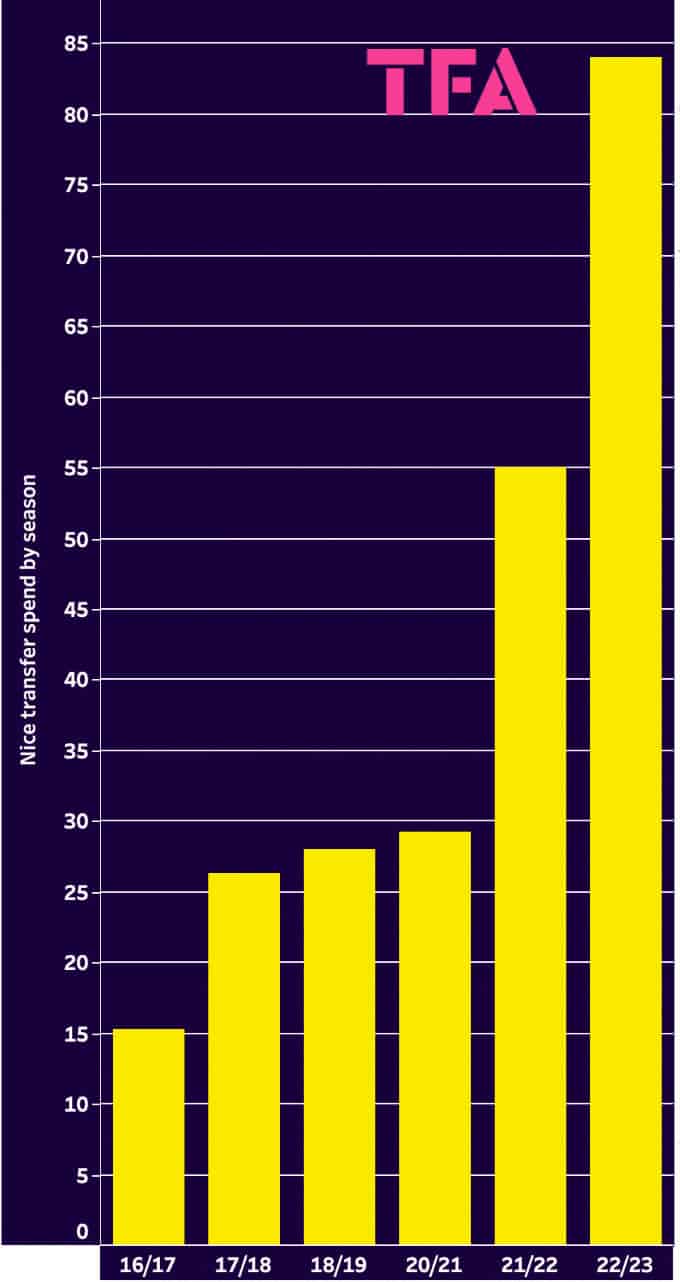
As figure 1 shows, Nice’s transfer expenditure steadily increased from 2016/17 to 2018/19 but has skyrocketed over the past two seasons. Despite this, Nice haven’t really splashed massively on any one player, the largest signing of the last two seasons being €22m on Sofiane Diop, pending Terem Moffi’s €22.5m transfer this coming summer which we haven’t included in this graph.
The €22m spent on Diop is obviously a big sum but in the context of top-level football, it’s not a mindblowing amount in 2023. The last two seasons have also seen the likes of Gaëtan Laborde (€15m), Calvin Stengs (€15m) and Andy Delort (€10m) signed — a mixture of youth and experience. Generally, the money has tended to be spread out among multiple signings of similar stature as opposed to one or two big marquee transfers.
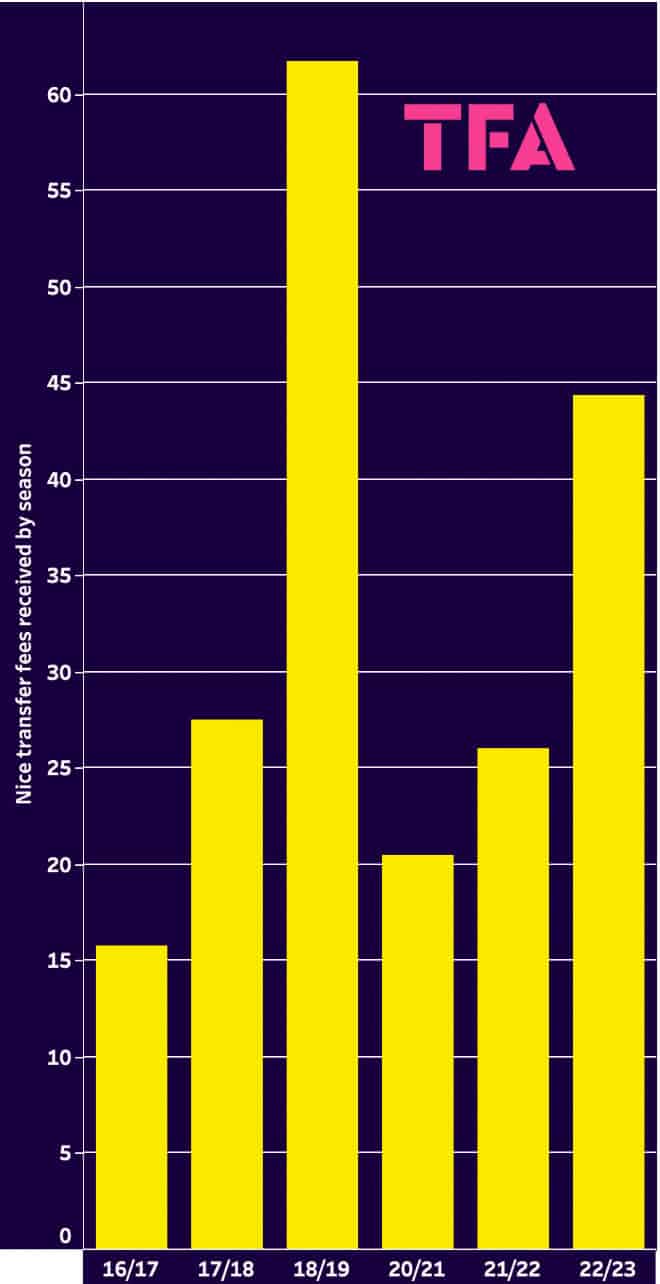
This has come at a time when Nice’s transfer fees received have been steadily rising but, all the same, largely stayed below the levels they were reaching prior to INEOS’ takeover.
The fall in transfer fees received aligns with the rise in transfer fees paid and highlights a marked change in recruitment strategy under INEOS compared to before. While Nice are the third-biggest spenders (net) for the last three seasons in Ligue 1 with a loss of €77.27m, they made the sixth-biggest transfer profit (net) from 2016/17-2018/19 — €35.45m.
On one hand, this highlights that INEOS are happy to invest money into the club transfer-wise but that does not equate with success, as Nice’s league performance in this time has reflected. While they’ve gone from ninth to fifth to where they currently sit in eighth place over the last three seasons, they finished third, eighth and seventh from 2016/17 to 2018/19, which is actually a higher average despite spending far less money.
Some of Nice’s signings have not been home runs, which hasn’t helped matters. For example, from this past summer, €22m Diop has played just 35% of his team’s league minutes this term, €13m Mattia Viti has played just 21% of Nice’s Ligue 1 minutes and €12m Alexis Beka Beka has enjoyed just 13% of his side’s Ligue 1 gametime.
From previous summers, Delort is now out on loan at Nantes, Stengs is out on loan at Royal Antwerp and €8m Robson Bambu is out on loan at Vasco da Gama.
This may not be a massive scouting issue, as there is such clear ability in most of these players mentioned that it’s difficult to say the players just aren’t up to scratch. However, regardless of whether it’s been a failure in recruitment — ability-wise or personality-wise — or just a failure of the team to properly integrate players into the squad and area, it’s clear that money has been wasted in the INEOS era at Nice and this is something that needs to be rectified.
It’s well and good to be willing to spend money as a football club owner but wasting money can end up just as frustrating for fans as unwillingness to spend at all.
Squad age
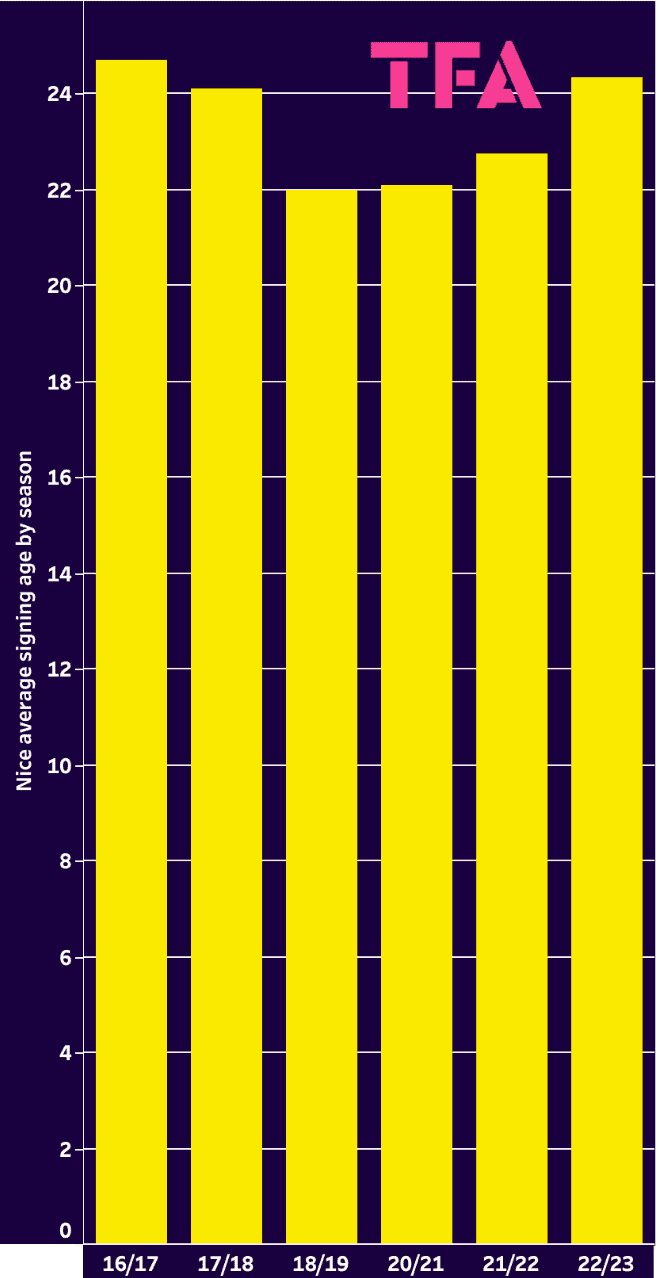
Figure 3 further highlights Nice’s comfort with mixing young signings and more experienced signings as part of their recruitment strategy. Above, we mentioned Delort and Laborde, who were 29 and 28, respectively, at the time of their arrival at the Allianz Riviera, along with Stengs and Diop, who were both 22 years old when they joined the Provence-Alpes-Côte d’Azur outfit. So, age and/or youth isn’t a major concern when it comes to the INEOS-led recruitment.
It’s notable, however, that at a time when Ligue 1 squads rapidly got younger en-masse, Nice have reversed their buying trends from progressively getting younger to progressively getting older since INEOS have taken charge.
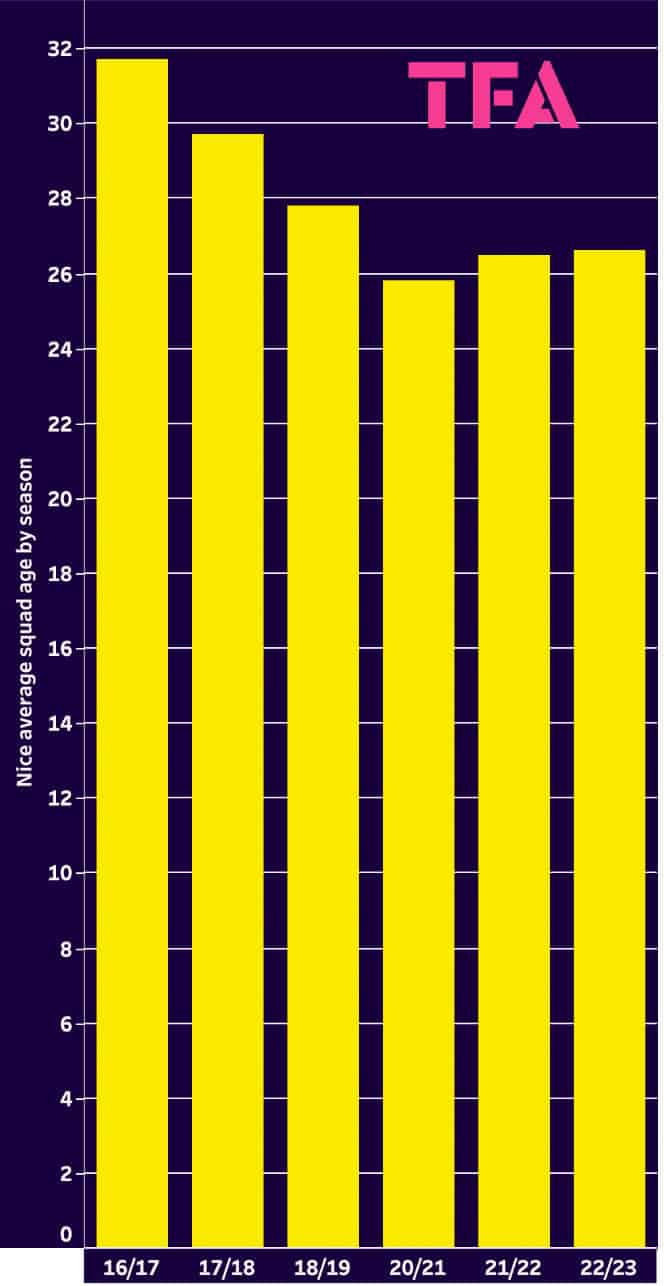
This trend isn’t just observed in their signings, but also in how the average age of their squad has changed from 2016/17-2018/19 and from 2020/21-2022/23.
While their squad got progressively younger season-on-season in the pre-INEOS era, they’ve got progressively older in the INEOS era, though not at the same rate in terms of years.
However, again, Ligue 1’s average age has sharply dropped in this time. In 2016/17, the average age of a Ligue 1 squad was 32.48. By 2018/19, it was 30.16 and in 2022/23, it’s down at 26.5.
So, while Nice’s average age was 31.7 in 2016/17, this was the league’s seventh-youngest team that season. In 2018/19, the last season before INEOS took over, Nice’s 27.8 was the second-youngest squad in France’s top flight.
Things have steadily shifted in the opposite direction season-by-season since Ratcliffe’s administration has been in town and now, Nice have the eighth-oldest squad in Ligue 1. This is the oldest their squad has been relative to other teams in France’s top flight in all of the seasons we’ve analysed for this piece, indicating what direction the club is moving in.
The way the average age has moved could point to an element of short-termism in INEOS’ approach to club ownership which may also be reflected in the managerial merry-go-round that’s established itself at the Allianz Riviera since Ratcliffe’s takeover. Nice have had more than twice as many managers in the past three seasons (five) as they’d had between 2016/17 and 2019/20 (two).
Mid-season sackings used to be rare at Nice, with Claude Puel (manager for 1499 days) leaving at the end of the 2015/16 season to make way for Lucien Favre (manager for 729 days in his first tenure), who then left in June 2018.
Since then, Patrick Vieira was in charge for a period of time at the end of the pre-INEOS era, the transitional period in 2019/20 and the start of the INEOS era. His tenure lasted 887 days but ended in December 2020 when he was dismissed and replaced by Adrian Ursea.
Ursea’s tenure lasted until the end of the season when title-winning coach Christophe Galtier joined Nice after leaving Lille. He stayed at the Allianz Riviera for one season before leaving for PSG, making way for Favre’s return, though that was short-lived with the Swiss coach being sacked in January and being replaced by 36-year-old Didier Digard, who’s currently in charge.
Things have been more turbulent in Les Aiglons’ hot seat since INEOS took over and while the owners certainly seem ambitious, perhaps their transfer strategy and managerial appointments indicate that they can improve in terms of long-term strategy to start making their way back towards the third place finish they achieved in 2016/17 and have failed to get anywhere near since, despite being the third-biggest net spenders for the last three campaigns.
Use of the academy
INEOS’ Nice takeover and the increase in their average squad age have come at the same time as a sharp dropoff in the club’s use of the academy.
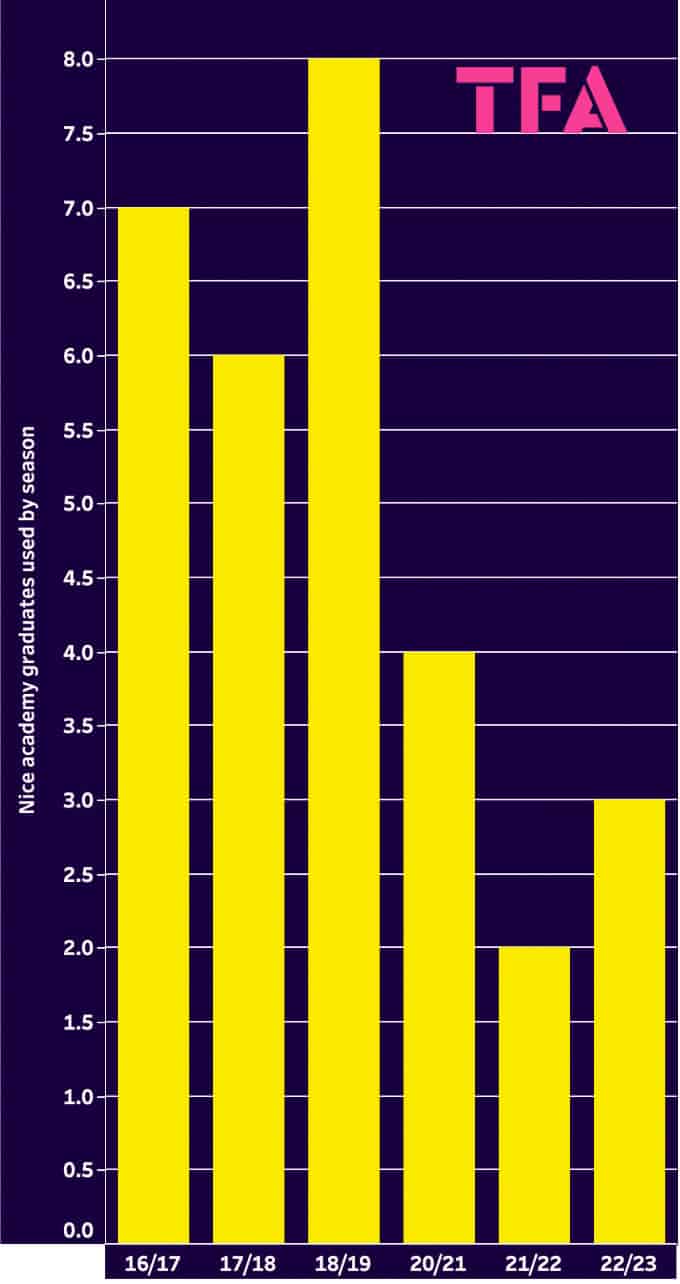
From 2016/17 to 2018/19, seven, six, and eight academy graduates featured for Nice in those respective seasons. However, just four, two and three academy products have played for Les Aiglons in the league from 2020/21 to the present season. We see this illustrated in figure 5.
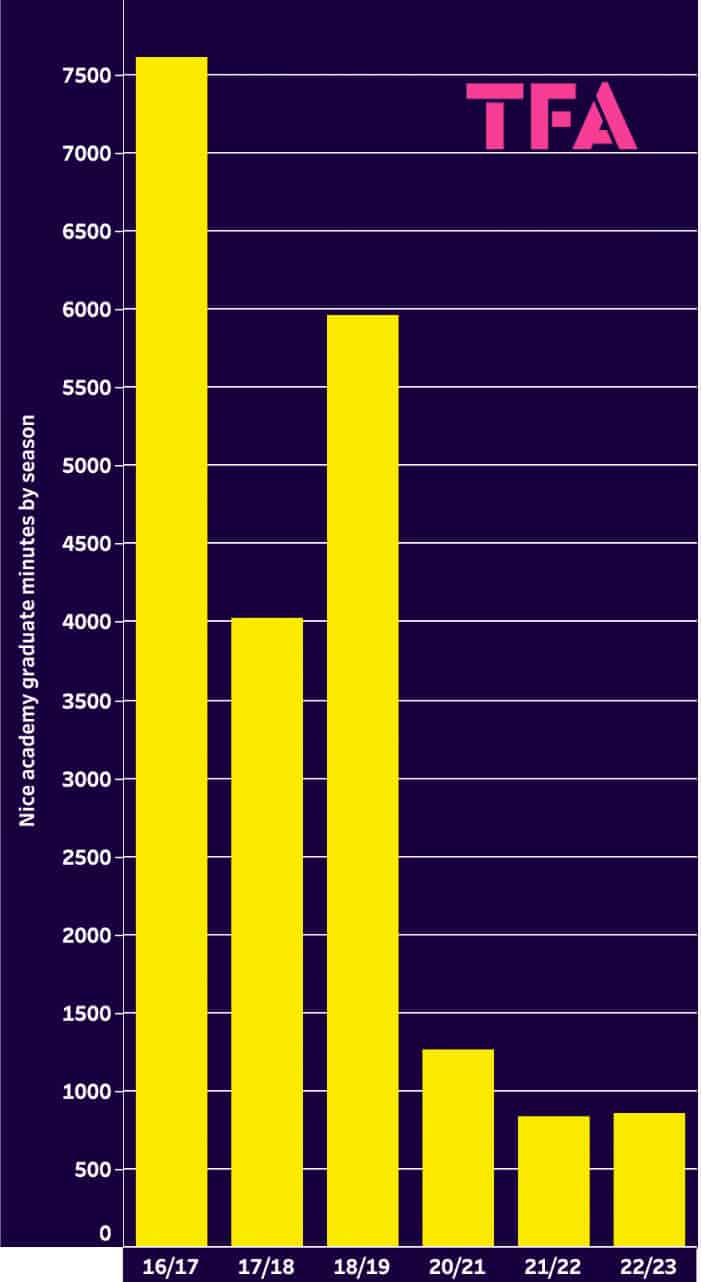
There’s also been a sharp dropoff in minutes played by Nice’s academy graduates in that time, which highlights that it wasn’t just a case of a few more academy graduates getting cameo appearances before, but a real change in first-team academy presence.
Per a post from CIES Football Observatory back in January, at that time, just 0.1% of Nice’s league minutes this season had been played by club-trained players. This was the second-lowest in France’s top flight behind only Marseille, who had failed to give any minutes to club-trained players by that point.
By any standard, this is an alarming drop off in the club’s use of the academy and a rate of using academy players that wouldn’t be considered ideal for any side in the world. You’d want to show greater evidence of a pathway from the academy to the first team, which Nice have failed to do under INEOS. This is undoubtedly a major area of improvement for Ratcliffe’s administration.
Given how much Manchester United pride themselves on their academy, the lack of emphasis on this area from INEOS at Nice is something their fans and those involved with the club should be aware of in the event of any Ratcliffe takeover.
Conclusion
To conclude this analysis, we think there are some clear areas of improvement for INEOS at Nice which could also point to important areas to look out for should INEOS end up in charge of Manchester United or, indeed, any other club.
Again, things haven’t been all bad at Nice during Ratcliffe’s time with the Provence-Alpes-Côte d’Azur club but the expectations were always higher than this following the takeover and the amount of investment the club has seen.
Perhaps INEOS’ Nice will end up being a success story but for now, it remains underwhelming in a time when the likes of Lille, Lens and Monaco have provided really exciting stories to watch unfold in France’s top flight outside of the PSG dominance.

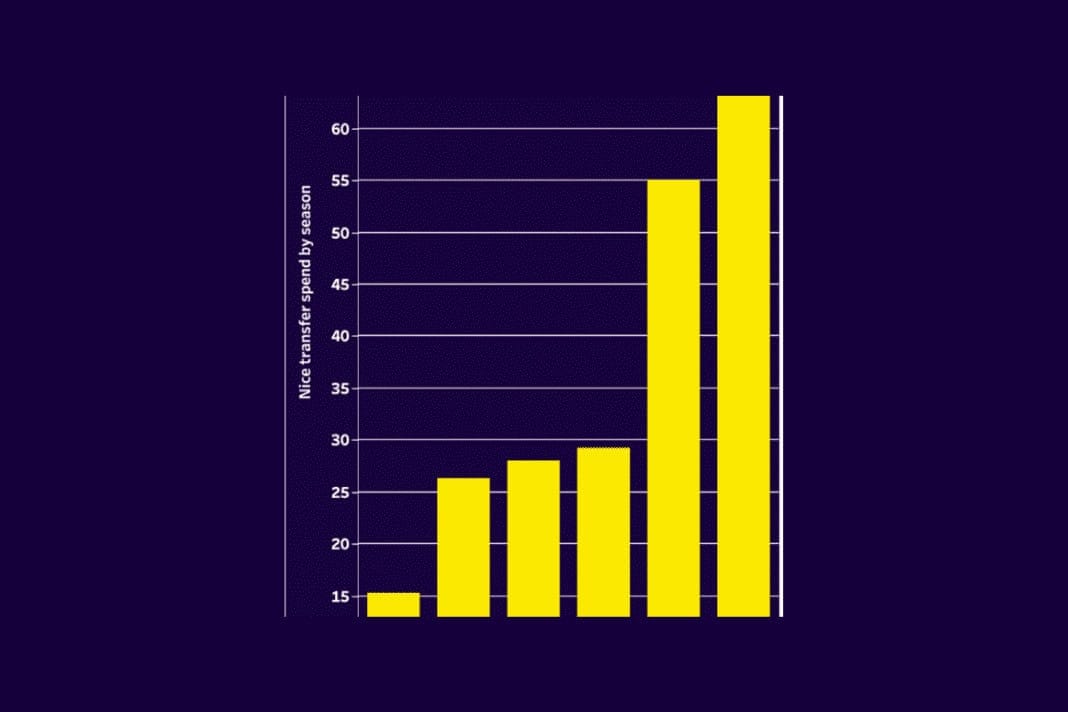



Comments